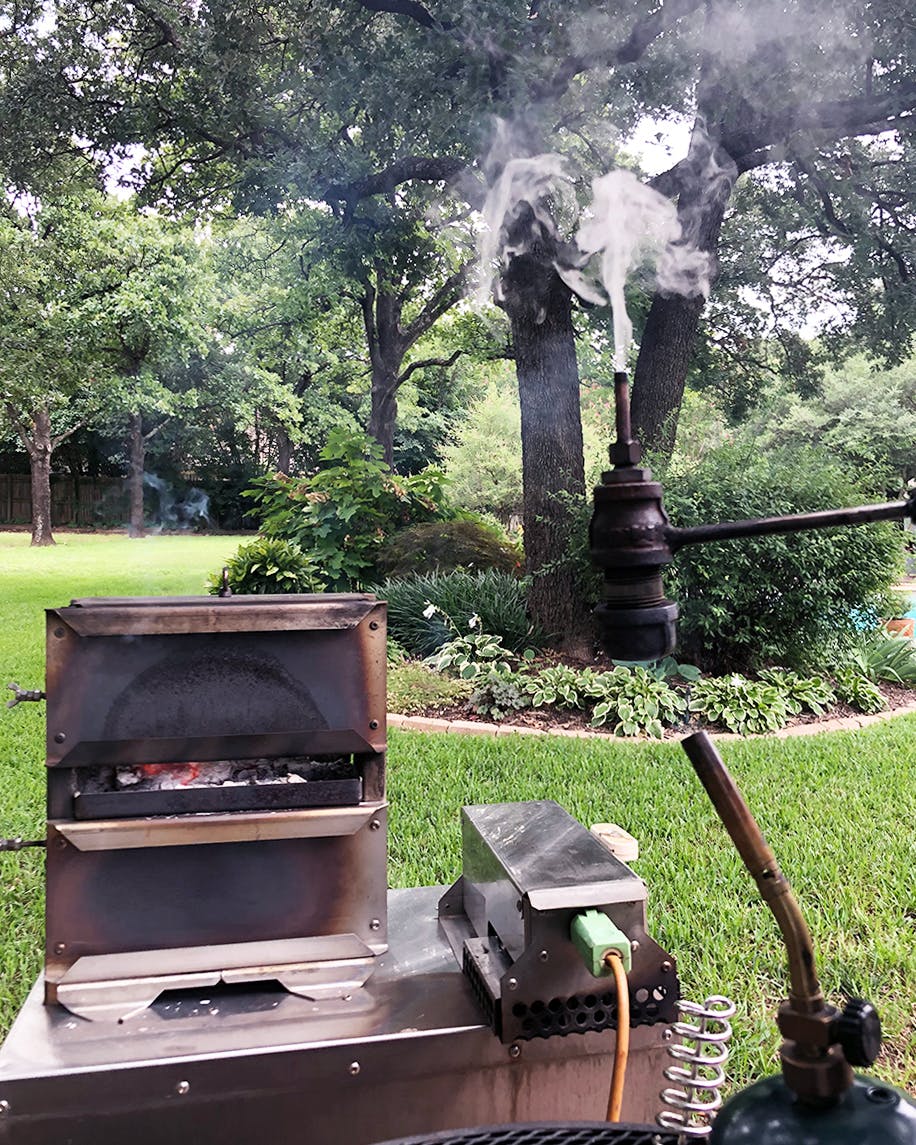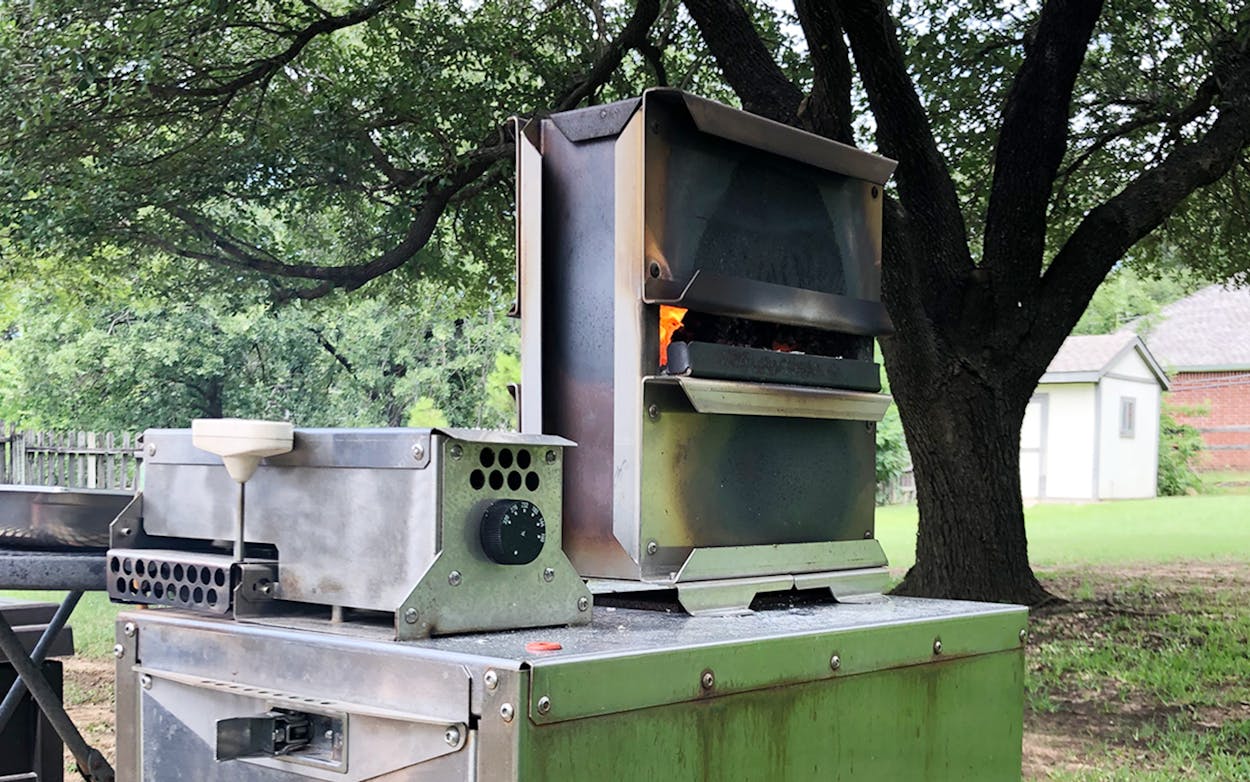Predictability is a foreign concept when it comes to wood fires in a barbecue smoker. Proper control of the coals and smoke produced by burning wood over the course of a dozen or so hours is what separates good barbecue from bad. Achieving that consistently, day after day, is what makes one a master of the pit. Bill Karau, founder of KBQ smokers, understood this when he set out to design a smoker. He felt that developing the perfect smoke for barbecue shouldn’t be so difficult.
An engineer by training, Karau began designing smokers in 2004 after years of back-road barbecue trips through Texas and beyond. As he suffered the intestinal distress caused by too much creosote (the condensate of dirty smoke, an issue we’ve explored in the past), he got more selective about what he ate. He’d inspect an establishment’s smokers for signs of dirty smoke, like black sludge dripping down the sides of the exhaust. Stalactites of black tar on the smokehouse ceiling gave him enough pause that he might wait until the next stop to eat any barbecue. After too many unpleasant experiences, he set to work on his own smoker design, convinced that it couldn’t be that hard to produce a consistent supply of clean smoke.
Karau spent the next four years failing through seventeen versions of his design. (Karau recorded each attempt on a timeline.) “I would fire one up, and sometimes within minutes, I’d be like, disaster. No chance. Fail. Epic fail,” he told me, still scarred from the experience of having spent hundreds of hours welding a firebox with a counterflow stainless steel heat exchanger, only to learn almost immediately that it didn’t work.
Karau can’t say whether it was hubris or determination that pushed him to continue, but in 2008 he had a breakthrough. Model 18 employed his revolutionary “inverted flame firebox,” for which Karau has since secured three patents. Unlike a grill, where the heat is located below the meat, or an offset smoker, where the cooking chamber is beside the firebox, in the KBQ the firebox is on top of the smoking chamber. It’s designed this way so that the smoke can be drawn by an electric fan (this smoker needs to be plugged in) down through the bed of hot coals from the burning wood. The coals form a sort of filter for the smoke that passes through them, which burns away the impurities we call dirty smoke—leaving only the sweet smoke flavors. Karau likens the process to refining crude oil into kerosene.

“It’s all so obvious now, it’s embarrassing that it took four years to figure it out,” Karau said. The concept sounded too simple to make a considerable flavor difference in the meat until Karau gave me a taste of unfiltered dirty smoke. He placed a small cylinder of oak wood into a metal tube, threaded on one end and closed on the other, with a long handle. He screwed a lid overtop with a tiny smokestack, no larger than a stir straw, then lit a propane torch and began heating the metal tube. Once the tube heated up enough, the wood inside started to burn but produced no flame. Thick smoke poured from the top of that tiny chimney. I licked my finger, so the smoke would stick, and held it out to gather some smoke. The taste was wretched, like the flavor of a dirty ashtray. Then he moved the torch’s flame upward to meet the smoke. It ignited. The visible smoke all but disappeared, and the smell of smoke turned sweeter.
Smoke is as much an ingredient in barbecue as salt and pepper. There are many varieties of salt one can use to season meat, and how long ago your pepper was ground will affect its potency. The quality, not just the quantity, of smoke also matters. “How the smoke is combusted has an enormous impact on the flavor profile,” Karau said. “The longer the hydrocarbon chains are, the more bitter it tastes, and the darker the color profile gets. When those are cracked into shorter and shorter hydrocarbon chains, the lighter and sweeter the flavor profile and the more towards mahogany and burgundy the coloration tends to get.” Burning the smoke is what breaks those hydrocarbon chains down. Flames are the visible evidence of dirty smoke being cleansed.
“Wood is not a fuel. It’s a fuel source,” Karau explained. As it’s burning, wood turns into two fuels. There’s the solid fuel of charcoal (which is what remained inside the metal tube after his smoke demonstration was complete) and the gaseous fuel of smoke. A visible flame is a good sign for barbecue, because it means the smoke is being burned. When a fire is starved of oxygen and the flames are extinguished, the heat from the charcoal remains, but the smoke isn’t consumed as fuel. In an offset smoker, that dirty, unburned smoke goes into the cook chamber. Some of it is evacuated through the exhaust, but much of it settles onto the meat.
You might now be wondering how the KBQ produces only clean smoke. It doesn’t, and that’s the genius of the design. Karau isn’t a pitmaster, and he doesn’t expect his customers to be either. You just have to keep feeding small pieces of wood (Karau prefers mesquite) into the small, steel firebox. A thermostat controls the fan that delivers heat and smoke into the cooking chamber. When the fan is on, the smoke it brings in is cleansed by the coal bed before it reaches the meat. The rest of the smoke, dirty or not, exhausts into the air in the opposite direction of the barbecue, unless you don’t want it to.
Karau includes one additional inlet into the smoker chamber that can remain closed or opened a bit to let in dirtier smoke for those who like a smoky punch to their barbecue. “The big advantage of this is that you can control how the smoke is burned and whether it’s burned very thoroughly, or not thoroughly at all,” Karau said. He has no problem with people directing dirty smoke into the KBQ, as long as it’s done intentionally. He didn’t let any in when he prepared a few racks of expertly smoked ribs for me to sample in his backyard. My fears that his smoker might produce an overly sanitized version of barbecue had been assuaged by the time I’d reached for my fifth rib.
Through Karau’s study of smoke and combustion, he’s uncovered several bits of wisdom useful even to those who already own an offset smoker and don’t plan to buy a KBQ. Fire is power, which raises the temperature of the smoker and produces smoke. Increasing that power is easier than decreasing it. Start by developing a good coal bed in the firebox for heat and use smaller pieces of wood to keep the fire going. This will keep the cooker’s temperature from spiking, or as Karau calls it, “experiencing a heat excursion,” when fresh wood is added. To decrease the power of the fire, remove wood or coals rather than closing dampers or exhausts. “Restricting combustion air through the use of a damper does not change the rate at which smoke is being generated,” Karau said. In other words, the temperature of the cooker might go down when you stifle the fire, but only because the smoke has stopped burning, and smoke that is burning tastes better.

Karau figures he has sold about a thousand of his C-60 smoker model, a stainless steel box that resembles an electric cabinet smoker. It currently goes for $1,440, plus shipping. Back when we profiled him in 2010, he was using the name Karubecue and building his older B-30 model, which looked more like a grill. At the end of that story, he said, “My wife will be happy when she can park in the garage again,” but she’s had no such luck. They’re all still built by Karau in his garage. There’s a much larger rotisserie version that’s manufactured out of state, the KBQ-400, which holds about four hundred pounds of meat and uses the same inverted flame firebox. Karau said you don’t have to be a pitmaster to operate it, nor must you understand the principles of smoke production. “You’re going to make kick-ass barbecue the first time,” he promises.
- More About:
- Business








